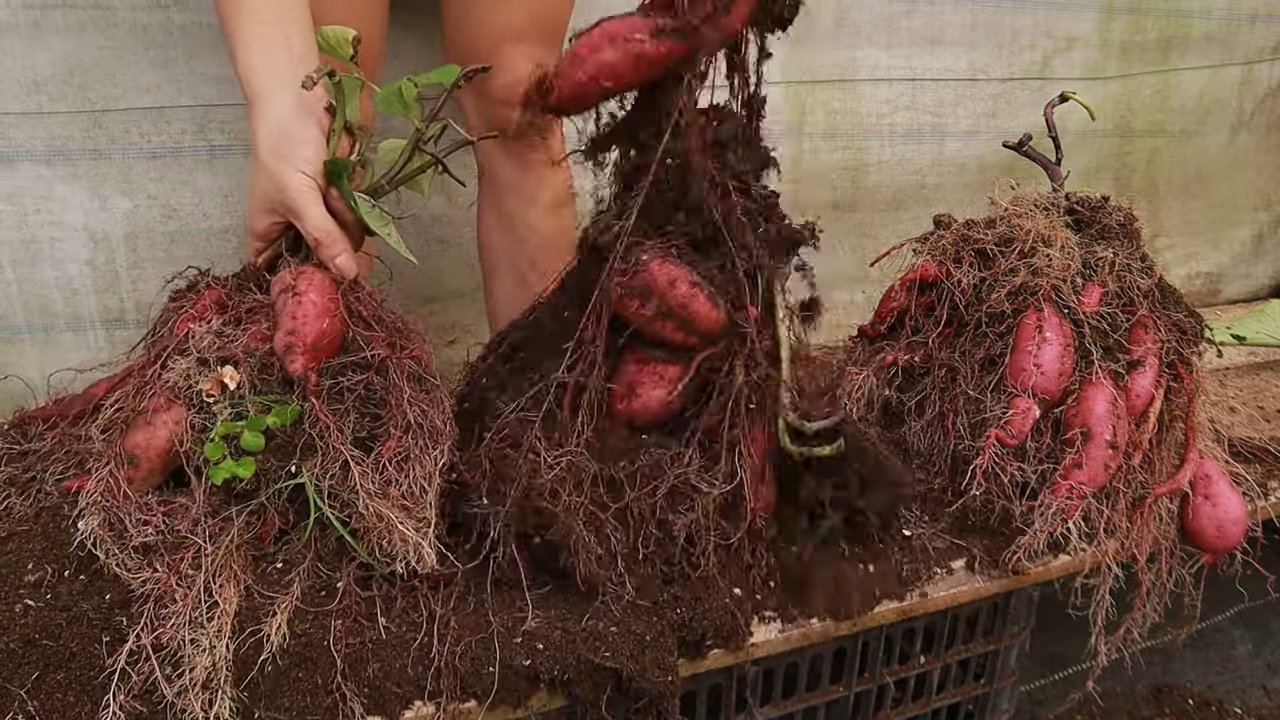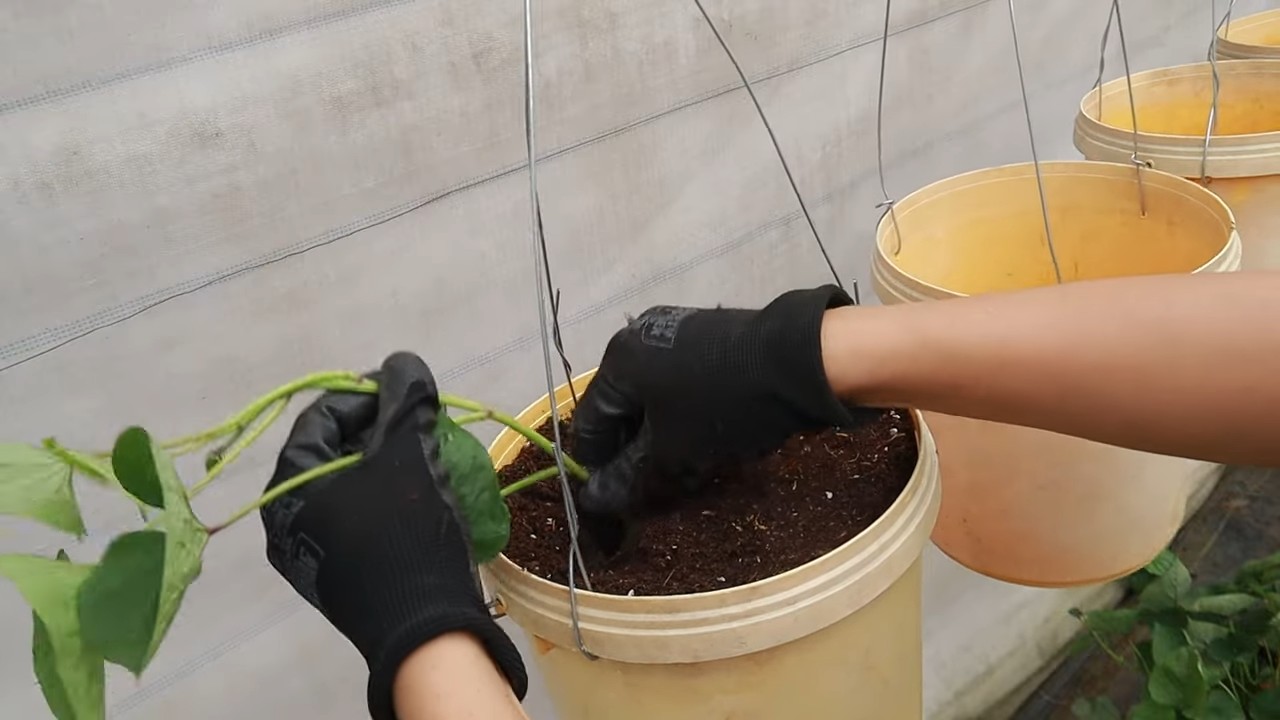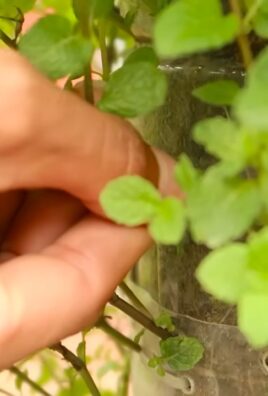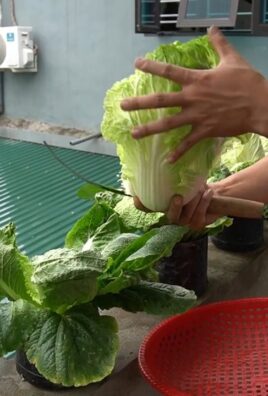Hanging sweet potatoes harvest – the words alone conjure images of lush, cascading vines laden with vibrant, earthy treasures! Have you ever dreamt of transforming your balcony, patio, or even a sunny corner of your kitchen into a miniature, edible jungle? Well, get ready to turn that dream into reality with these simple, yet incredibly effective, DIY tricks for maximizing your hanging sweet potato harvest!
For centuries, sweet potatoes have been a staple in diets around the globe, revered not only for their delicious flavor but also for their impressive nutritional value. From the indigenous cultures of South America, where they originated, to their widespread adoption in Asian and African cuisines, sweet potatoes have nourished generations. But did you know you can grow them in hanging baskets?
Let’s face it, not everyone has access to a sprawling garden. Space is often a premium, especially in urban environments. That’s where the magic of vertical gardening comes in! Growing sweet potatoes in hanging baskets allows you to bypass the limitations of traditional gardening, making it possible to enjoy a bountiful harvest even in the smallest of spaces. Plus, it’s a fantastic way to add a touch of greenery and personality to your home. I’m excited to share these easy-to-follow tips and tricks that will help you achieve an abundant hanging sweet potatoes harvest, right at your fingertips. Get ready to get your hands dirty (just a little!) and enjoy the sweet rewards of your labor!

DIY Hanging Sweet Potato Harvest: A Bountiful Bounty from Above!
Hey there, fellow gardeners! I’m so excited to share this super cool and space-saving way to grow sweet potatoes: hanging them! Not only does it look amazing, but it’s also a fantastic solution if you’re short on garden space or just want to try something a little different. And the best part? Harvesting is a breeze! Let’s dive into how you can create your own hanging sweet potato garden and reap a delicious harvest.
What You’ll Need:
Before we get started, let’s gather our supplies. This is a relatively simple project, so you probably have a lot of these items already!
* Large Hanging Baskets: I recommend baskets that are at least 14 inches in diameter and 12 inches deep. The bigger, the better, as sweet potatoes need room to grow. Wire baskets with coco liners work great, but you can also use plastic hanging pots with drainage holes.
* Sweet Potato Slips: These are sprouts grown from sweet potatoes. You can buy them online, at your local garden center, or even grow your own (more on that later!).
* Potting Mix: Use a high-quality potting mix that drains well. A mix specifically designed for vegetables is ideal.
* Slow-Release Fertilizer: Sweet potatoes are heavy feeders, so a slow-release fertilizer will provide them with the nutrients they need throughout the growing season.
* Watering Can or Hose: For, well, watering!
* Gloves: To keep your hands clean and protected.
* Scissors or Pruning Shears: For trimming any unruly vines.
* Strong Hanging Hardware: Make sure your hooks or chains are strong enough to support the weight of the filled baskets, which can get quite heavy.
* Optional: Mulch (like straw or wood chips) to help retain moisture.
Growing Your Own Sweet Potato Slips (Optional, but Fun!)
If you’re feeling adventurous, you can grow your own sweet potato slips. It’s a fun project and a great way to save money.
1. Choose a Sweet Potato: Select a healthy, organic sweet potato. Avoid any that are bruised or damaged.
2. Prepare the Sweet Potato: You have two options here:
* Water Method: Suspend the sweet potato in a jar or glass of water, with the bottom half submerged. You can use toothpicks to hold it in place.
* Soil Method: Bury the sweet potato horizontally in a container filled with moist potting mix, leaving the top exposed.
3. Provide Warmth and Light: Place the jar or container in a warm, sunny location.
4. Wait and Watch: In a few weeks, you should start to see sprouts (slips) emerging from the sweet potato.
5. Harvest the Slips: Once the slips are about 6-8 inches long, gently twist or cut them off the sweet potato.
6. Root the Slips: Place the slips in a glass of water, making sure the bottom inch or two is submerged. Roots should develop in a few days.
7. Plant the Slips: Once the roots are about an inch long, they’re ready to be planted in your hanging baskets!
Planting Your Sweet Potato Slips in Hanging Baskets
Now for the main event! This is where the magic happens.
1. Prepare the Hanging Baskets: Line your hanging baskets with coco liners (if using wire baskets). This will help retain moisture and prevent the soil from falling out.
2. Fill with Potting Mix: Fill the baskets with your high-quality potting mix, leaving a few inches of space at the top.
3. Add Slow-Release Fertilizer: Mix the slow-release fertilizer into the potting mix according to the package directions.
4. Plant the Slips: Gently dig small holes in the potting mix, spaced about 6-8 inches apart. Carefully remove the sweet potato slips from the water (if you rooted them) and plant them in the holes, burying the roots.
5. Water Thoroughly: Water the baskets thoroughly after planting, until the water drains out of the bottom.
6. Add Mulch (Optional): Add a layer of mulch to the top of the soil to help retain moisture and suppress weeds.
Caring for Your Hanging Sweet Potato Plants
Now that your sweet potato plants are happily hanging, it’s time to give them the TLC they need to thrive.
1. Watering: Sweet potatoes need consistent moisture, especially during hot weather. Water deeply whenever the top inch of soil feels dry to the touch. Be careful not to overwater, as this can lead to root rot.
2. Sunlight: Sweet potatoes need at least 6-8 hours of sunlight per day. Choose a location that receives plenty of sun.
3. Fertilizing: In addition to the slow-release fertilizer, you can supplement with a liquid fertilizer every few weeks. Follow the package directions for application.
4. Pruning: Sweet potato vines can get quite long and unruly. You can prune them back as needed to keep them under control. This will also encourage the plants to focus their energy on producing tubers.
5. Pest Control: Keep an eye out for pests like aphids, spider mites, and sweet potato weevils. Treat any infestations promptly with an appropriate insecticide or organic pest control method. I personally prefer neem oil for most garden pests.
6. Support: As the sweet potatoes grow, the vines may become heavy. You may need to provide additional support to the baskets to prevent them from breaking.
Harvesting Your Hanging Sweet Potatoes
This is the moment we’ve all been waiting for! Harvesting your sweet potatoes is the most rewarding part of the process.
1. Timing: Sweet potatoes typically take about 90-120 days to mature. You’ll know they’re ready to harvest when the vines start to turn yellow and die back.
2. Prepare for Harvest: Before you start digging, make sure the soil is relatively dry. This will make it easier to harvest the sweet potatoes without damaging them.
3. Harvesting: This is where the hanging basket method really shines! Instead of digging in the ground, you can simply tip the basket over and gently remove the sweet potatoes. Be careful not to bruise or cut the tubers.
4. Curing: Curing sweet potatoes is essential for developing their sweetness and improving their storage life.
* Clean the Sweet Potatoes: Gently brush off any excess soil from the sweet potatoes. Do not wash them.
* Curing Environment: Place the sweet potatoes in a warm, humid place (80-85°F and 85-90% humidity) for about 7-10 days. A greenhouse, garage, or even a warm room in your house can work.
* Arrangement: Spread the sweet potatoes out in a single layer, making sure they don’t touch each other.
* Monitoring: Check the sweet potatoes regularly for any signs of rot or damage. Remove any that are starting to spoil.
5. Storing: After curing, store the sweet potatoes in a cool, dry, and dark place (55-60°F). They should keep for several months.
Troubleshooting
Even with the best planning, sometimes things don’t go exactly as expected. Here are a few common problems you might encounter and how to fix them:
* Yellowing Leaves: This could be a sign of overwatering, underwatering, or nutrient deficiency. Check the soil moisture and adjust your watering accordingly. Fertilize with a balanced fertilizer if needed.
* Slow Growth: This could be due to insufficient sunlight, poor soil, or pests. Make sure your plants are getting enough sun and that the soil is well-draining and fertile. Check for pests and treat them promptly.
* Small Tubers: This could be due to insufficient nutrients, overcrowding, or a short growing season. Make sure you’re fertilizing regularly and that your plants have enough space to grow.
* Root Rot: This is usually caused by overwatering. Make sure your baskets have good drainage and that you’re not watering too frequently.
Why Hanging Sweet Potatoes is Awesome
* Space-Saving: Perfect for small gardens, balconies, or patios.
* Easy Harvesting: No more digging!
* Pest Control: Hanging baskets can help reduce pest problems.
* Aesthetic Appeal: Sweet potato vines are beautiful and add a touch of greenery to any space.
* Fun and Unique: It’s a great conversation starter!
So there you have it! Growing sweet potatoes in hanging baskets is a fun, rewarding, and space-saving way to enjoy a delicious harvest. I hope you give it a try! Happy gardening!

Conclusion
So, there you have it! Transforming your sweet potato harvest into stunning, space-saving hanging planters is more than just a clever gardening hack; it’s a celebration of resourcefulness, a touch of artistic flair for your home, and a sustainable way to enjoy the fruits (or rather, vegetables) of your labor. This DIY trick is a must-try because it elegantly solves several problems at once. It addresses the challenge of limited garden space, allowing even apartment dwellers to cultivate their own sweet potatoes. It provides an aesthetically pleasing alternative to traditional storage methods, turning your harvest into a living, breathing piece of art. And perhaps most importantly, it extends the life of your sweet potatoes, allowing you to enjoy their deliciousness for longer.
But the beauty of this method lies in its adaptability. Feel free to experiment with different types of containers. While burlap sacks offer a rustic charm, repurposed plastic containers or even old hanging baskets can work just as well. Just ensure adequate drainage to prevent waterlogging. Consider adding companion plants like herbs (thyme or rosemary work wonderfully) to the top of the container for added visual appeal and pest control. You can also vary the size of the sweet potatoes you use, creating a cascading effect with larger potatoes at the bottom and smaller ones towards the top.
Don’t be afraid to get creative with the placement of your hanging sweet potato planters. A sunny porch, a balcony railing, or even a well-lit indoor space can become a thriving sweet potato haven. Remember to monitor the moisture levels regularly and adjust your watering schedule accordingly. Overwatering can lead to rot, while underwatering can cause the potatoes to shrivel.
Ultimately, this DIY hanging sweet potato planter is about more than just growing vegetables; it’s about connecting with nature, embracing sustainability, and adding a touch of personal style to your living space. It’s a conversation starter, a source of pride, and a delicious reminder of the bounty of the earth.
We wholeheartedly encourage you to try this DIY trick with your next sweet potato harvest. It’s a rewarding experience that will transform the way you think about food storage and gardening. And most importantly, we want to hear about your experiences! Share your photos, tips, and variations on social media using #HangingSweetPotatoes and let’s create a community of resourceful gardeners who are passionate about sustainable living. Let’s see your amazing hanging sweet potato creations! We are confident that you will find this method a delightful and practical way to showcase and preserve your **sweet potato harvest**.
FAQ
What kind of sweet potatoes work best for hanging?
Generally, any variety of sweet potato can be used for this method. However, some varieties might be more visually appealing or have better storage qualities. Beauregard sweet potatoes, with their vibrant orange flesh and smooth skin, are a popular choice. Jewel sweet potatoes, known for their reddish-orange skin and moist flesh, are another excellent option. Consider the size and shape of the sweet potatoes as well. Medium-sized, relatively uniform potatoes are easier to work with and create a more balanced aesthetic. Avoid using sweet potatoes that are already showing signs of sprouting or decay, as they are less likely to store well.
How do I prepare the sweet potatoes for hanging?
The preparation is quite simple. First, gently wash the sweet potatoes to remove any dirt or debris. Avoid scrubbing too hard, as this can damage the skin and make them more susceptible to rot. Allow the sweet potatoes to dry completely before placing them in the container. This helps prevent the growth of mold and bacteria. If you notice any small sprouts starting to emerge, you can carefully remove them, but it’s not essential. The sprouts will eventually grow and add to the visual appeal of the hanging planter.
What type of container is best for hanging sweet potatoes?
The choice of container is largely a matter of personal preference and available resources. Burlap sacks are a popular choice due to their rustic charm and breathability. However, they can be prone to tearing over time. Repurposed plastic containers, such as old buckets or storage bins, are a more durable option. Just be sure to drill drainage holes in the bottom to prevent waterlogging. Hanging baskets, especially those made from wire or wicker, can also be used. Line the basket with burlap or coconut coir to prevent the soil from falling through. Regardless of the container you choose, ensure that it is strong enough to support the weight of the sweet potatoes and the soil.
How often should I water my hanging sweet potato planter?
The watering frequency will depend on several factors, including the climate, the type of container, and the size of the sweet potatoes. As a general rule, water the planter when the top inch of soil feels dry to the touch. Avoid overwatering, as this can lead to root rot. During hot, dry weather, you may need to water more frequently. During cooler, wetter weather, you may need to water less frequently. A good way to check the moisture level is to insert your finger into the soil. If the soil feels damp, it’s best to wait before watering.
How much sunlight do hanging sweet potatoes need?
Sweet potatoes thrive in full sun, meaning they need at least 6-8 hours of direct sunlight per day. However, they can also tolerate partial shade, especially during the hottest part of the day. If you live in a particularly hot climate, consider placing your hanging sweet potato planter in a location that receives morning sun and afternoon shade. If you are growing your sweet potatoes indoors, you will need to supplement with artificial light. Grow lights are an excellent option for providing the necessary light for healthy growth.
How long will the sweet potatoes last in a hanging planter?
With proper care, sweet potatoes can last for several months in a hanging planter. The key is to provide them with the right conditions: adequate sunlight, proper watering, and good ventilation. Monitor the sweet potatoes regularly for signs of spoilage, such as soft spots or mold. Remove any potatoes that are starting to rot to prevent the spread of disease. As the sweet potatoes begin to sprout, they will eventually deplete their energy reserves and start to deteriorate. This is a natural process, and it’s a sign that it’s time to harvest the sprouts and enjoy your sweet potato bounty.
Can I eat the sprouts that grow from the sweet potatoes?
Yes! Sweet potato sprouts are not only edible but also quite nutritious. They have a slightly sweet and nutty flavor and can be used in a variety of dishes. Add them to salads, stir-fries, or soups. You can also sauté them with garlic and olive oil for a simple and delicious side dish. Sweet potato leaves are also edible and can be used in a similar way to spinach or kale. Just be sure to harvest the sprouts and leaves before they become too tough or bitter.
What do I do when the sweet potatoes start to sprout too much?
Excessive sprouting is a natural part of the sweet potato’s life cycle. When this happens, it’s a sign that the sweet potato is ready to be used. You can either harvest the sprouts and leaves for consumption or remove the sweet potatoes from the planter and use them in your favorite recipes. If you want to prolong the life of the sweet potatoes, you can try removing the sprouts as they appear. However, this will eventually weaken the sweet potato and shorten its lifespan.
Can I reuse the soil from the hanging sweet potato planter?
Yes, you can reuse the soil, but it’s important to replenish its nutrients. After harvesting the sweet potatoes, remove any remaining roots or debris from the soil. Amend the soil with compost or other organic matter to improve its fertility. You can also add a slow-release fertilizer to provide the plants with essential nutrients. Before reusing the soil, consider sterilizing it to kill any harmful pathogens or pests. You can do this by baking the soil in the oven at 200 degrees Fahrenheit for 30 minutes.
Is this method suitable for all climates?
While hanging sweet potato planters can be adapted to various climates, they thrive best in warm, sunny conditions. In colder climates, you may need to bring the planters indoors during the winter months to protect the sweet potatoes from frost. In extremely hot climates, provide some shade during the hottest part of the day to prevent the sweet potatoes from overheating. Monitor the moisture levels carefully and adjust your watering schedule accordingly. With a little bit of care and attention, you can successfully grow hanging sweet potatoes in a wide range of climates.




Leave a Comment